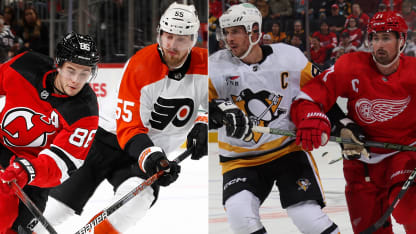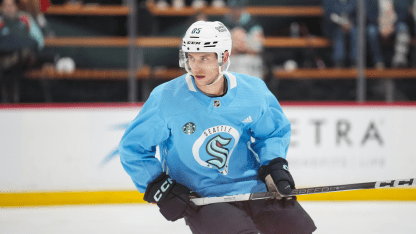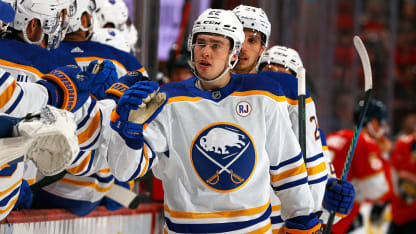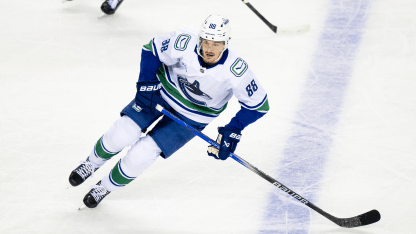How 8 Eastern Conference teams can get back into Stanley Cup Playoffs
How 8 Eastern Conference teams can get back into Stanley Cup Playoffs
Devils, Flyers, Penguins, Red Wings among those who didn't qualify last season

© Sarah Stier/Getty Images / Dave Reginek/NHLI via Getty Images
NHL.com continues its preview of the 2024-25 season.
For the eight Eastern Conference teams that missed the 2024 Stanley Cup Playoffs, their goal since the regular season ended has been determining how to extend their season into June, like the Stanley Cup champion Florida Panthers did.
So how can those teams take the next step? As training camps continue, NHL.com today examines why fans of the eight teams can hold onto their playoff hopes (teams listed in alphabetical order):
BUFFALO SABRES
Last season: 39-37-6, seven points out of second wild card
How it ended: A 9-4-1 run from Feb. 21 to March 18 got the Sabres as close as four points out of a playoff spot, but they lost three of their next four on their way to missing the postseason for the 13th straight season.
Biggest offseason change: Lindy Ruff, the last coach to guide the Sabres to the playoffs, is back behind the Buffalo bench 11 years and six coaches since being fired 17 games into the 2012-13 season. In 16 seasons as Sabres coach during his first run, he was 571-432-84 (78 ties) and got Buffalo into the playoffs eight times. They reached the 1999 Stanley Cup Final and made consecutive trips to the Eastern Conference Final in 2006 and 2007. The Sabres believe Ruff’s success developing a young core with the New Jersey Devils the past four seasons can give the Sabres’ emerging group enough of a boost reach the postseason for the first time since 2011.
Why they could get in: The Sabres have an enviable core of talent, led by forwards Tage Thompson, Alex Tuch, Dylan Cozens and Jack Quinn, and defensemen Owen Power, Rasmus Dahlin and Bowen Byram. Forwards Jason Zucker and Ryan McLeod were acquired during the offseason to add experience and scoring depth. Ukko-Pekka Luukkonen emerged as a true No. 1 goalie and was rewarded with a five-year contract. The talent is there for the Sabres to become a consistent playoff team, and with Ruff leading them, the end of the playoff drought is in sight.
COLUMBUS BLUE JACKETS
Last season: 27-43-12, 25 points out of second wild card
How it ended: The Blue Jackets’ season began in disarray when coach Mike Babcock resigned and was replaced by assistant Pascal Vincent on Sept. 18, four days before training camp started. Columbus lost 15 of its first 19 games (4-11-4) and finished with the fourth-worst record in the NHL. General manager Jarmo Kekalainen was fired Feb. 15 and Vincent was fired June 17.
Biggest offseason change: The Blue Jackets, and the hockey world, were rocked by the deaths of forward Johnny Gaudreau and his brother, Matthew, who died after they were struck by a car while riding bicycles Aug. 29. From a hockey standpoint, the Blue Jackets will find someone to play left wing on the top line, which had been Gaudreau’s spot during his two seasons in Columbus. But there’s no way to repair the hole left by his absence.
Why they could get in: Before the tragedy in August, the Blue Jackets signed Sean Monahan to a five-year contract July 1 to provide a veteran presence at No. 1 center after he had 59 points (26 goals, 33 assists) in 83 games with the Montreal Canadiens and Winnipeg Jets last season. It was the first time he played at least 70 games since 2019-20. His arrival, and taking on the harder matchups on a nightly basis, should make life easier for younger centers Adam Fantilli and Cole Sillinger, allowing them to thrive. There’s also talent on the wings, including Kirill Marchenko (23 goals), Boone Jenner (22), Dmitri Voronkov (18) and Yegor Chinakhov (16), plus forward James van Riemsdyk, a seven-time 20-goal scorer, signed a one-year contract Sept. 15. There’s a new general manager in Don Waddell and new coach in Dean Evason, and both have had success in their previous jobs. The grieving process will be long and arduous, but they’ll support the players with anything they feel is needed to cope with the loss of Gaudreau.
DETROIT RED WINGS
Last season: 41-32-9, tied for second wild card, missed on regulation wins tiebreaker
How it ended: The Red Wings won their final three games, but each came after regulation, leaving them tied in points with the Washington Capitals for the second wild card, but with five fewer regulation wins (32-27). It was the eighth straight season the Red Wings missed the playoffs, the longest drought in team history.
Biggest offseason change: Cam Talbot signed a two-year contract July 1 to provide more consistent goaltending than what Detroit got last season, including a .907 5-on-5 save percentage that was 26th in the NHL. The 37-year-old ranked in the top 10 in the NHL last season in goals-against average (2.50, sixth) and save percentage (.913, eighth) in 54 games with the Los Angeles Kings, and played in the NHL All-Star Game. He also was 12-9-4 in games when he faced at least 30 shots; last season Detroit allowed 32.4 shots on goal per game, seventh most in the NHL.
Why they could get in: A Red Wings offense that averaged 3.35 goals per game, the most among any team not to make the postseason, added forward Vladimir Tarasenko, who scored 23 goals in 76 games with the Ottawa Senators and Florida Panthers last season, and had nine points (five goals, four assists) in 24 games to help the Panthers win the Stanley Cup. Combine that with a returning Patrick Kane, a healthy Dylan Larkin, a more mature Lucas Raymond and Alex DeBrincat, and scoring shouldn’t be an issue. Talbot and Alex Lyon should provide a more reliable combination in goal; Lyon had a stretch of 14 wins in 21 games between Dec. 29 and Feb. 27, but playing an NHL career-high 44 games seemed to wear on him later in the season. If the Red Wings can cut down on the shots allowed per game, the more dependable goaltending combined with their high-end offensive attack could be enough to earn a wild card spot.
MONTREAL CANADIENS
Last season: 30-36-16, 15 points out of second wild card
How it ended: Despite losing center Kirby Dach in the second game of the season, the Canadiens went 5-3-1 in October, but they won just 10 of their next 28 games (10-14-4) to fade from playoff contention.
Biggest offseason change: The Canadiens made one of the most talked-about trades of the offseason, acquiring forward Patrik Laine from the Blue Jackets for defenseman Jordan Harris on Aug. 19. Laine played 18 games last season because of a broken clavicle and to receive treatment through the NHL/NHLPA Player Assistance program, and had asked for a trade out of Columbus. Laine is a six-time 20-goal scorer, including 22 in 55 games in 2022-23, but because of injuries and other issues has played 129 of 246 games the past three seasons (52.4 percent). However, his bravado remains intact, saying after the trade, “I don’t want to come back as a 30-goal scorer. I want to come back as a 40-, 50- (goal-scorer).”
Why they could get in: Laine is only 26 years old but brings a veteran presence to a young top-six forward group that is just starting to hit its prime. The top line of Nick Suzuki (33 goals), Cole Caufield (28) and Juraj Slafkovsky (20) all scored at least 20 goals last season and each is 25 or younger. Laine also could help Dach, who should be healthy after his season-ending knee injury sustained four periods into last season. The 23-year-old center had an NHL career-high 38 points (14 goals, 24 assists) in 58 games in 2022-23, his first season with Montreal. The addition of rookie defenseman Lane Hutson also should charge up the offense. The flashy 20-year-old had an assist in each of his two NHL games last season after signing his entry-level contract April 12. The goalie combination of Sam Montembeault and Cayden Primeau are solid, and helped Montreal to a .919 5-on-5 save percentage that was ninth in the NHL last season. If Laine can regain his high-scoring form and the young players continue their growth and have a good run of health, the Canadiens could push their way into the wild card hunt.
NEW JERSEY DEVILS
Last season: 38-39-5, 10 points out of second wild card
How it ended: The Devils had the first wild card into the playoffs on Jan. 5, but went 3-6-1 in their next 10 to enter the break for the 2024 NHL All-Star Game six points out of a playoff spot, a deficit too big to climb out of.
Biggest offseason change: The Devils turned their biggest weakness into a strength with the acquisition of goalie Jacob Markstrom from the Calgary Flames on June 19. Since 2019-20, the Devils have started an NHL-high 15 goalies. That includes five last season who combined for a .904 5-on-5 save percentage that was tied for 27th in the NHL despite New Jersey allowing 30.0 shots on goal per game, 18th in the League. Markstrom was a Vezina Trophy finalist in 2021-22 and his .857 high-danger save percentage last season led the NHL. With Markstrom and Jake Allen, who had a .900 save percentage in 13 games with the Devils last season after being acquired in a trade with the Canadiens on March 8, there’s finally stability in the position.
Why they could get in: Jack Hughes, healthy after shoulder surgery in April, heads an outstanding top-nine forward group that features five 20-goal scorers from last season. Defenseman Dougie Hamilton, who sustained a season-ending torn pec muscle on Nov. 28 last season, is healthy and leading a defense group that includes a more experienced Luke Hughes (when he returns in November from a shoulder injury) and Simon Nemec plus newcomers Brett Pesce and Brenden Dillon. If Markstrom and Allen stay healthy and play to their potential, the Devils should push for a top-three spot in the Metropolitan Division.
OTTAWA SENATORS
Last season: 37-41-4, 13 points out of second wild card
How it ended: After winning three of their first four games to start the season, Ottawa lost 16 of its next 24 (8-16-0) to fall to the bottom of the Eastern Conference standings. Coach D.J. Smith was fired Dec. 18, during a six-game losing streak. Coach Jacques Martin replaced him but didn’t have much better luck, and the Senators missed the postseason for the seventh straight season.
Biggest offseason change: The Senators believe they solved their goaltending issues with the acquisition of Linus Ullmark from the Boston Bruins on June 24. Ottawa allowed 29.7 shots on goal per game last season, tied for 13th in the NHL, but the combination of Joonas Korpisalo, Anton Forsberg and Mads Sogaard combined for a .900 5-on-5 save percentage that was the third worst in the League. And among the 46 goalies to play at least 30 games last season, Korpisalo was in the bottom 10 in save percentage (.890) and goals-against average (3.27). Ullmark, who won the Vezina Trophy as the best goalie in the NHL in 2023, ranked in the top 10 in those categories with a 2.57 GAA (tied for eighth) and .915 save percentage (tied for fifth). After sharing goalie duties with Jeremy Swayman in Boston the previous three seasons, the expectation is Ullmark will thrive as an undisputed No. 1 in Ottawa.
Why they could get in: New coach Travis Green has a lot of talent to work with, starting with a top line that featured two 70-point players in Brady Tkachuk (74) and Tim Stutzle (70), plus Claude Giroux, who had 64 points (21 goals, 43 assists) in 82 games at age 36. David Perron and Michael Amadio were signed in free agency to add depth to a forward group that includes Drake Batherson, Ridly Greig, Shane Pinto and a healthy Josh Norris following March shoulder surgery. Jake Sanderson, Thomas Chabot and Artem Zub will be the keys on defense, with Nick Jensen joining them after being acquired in a trade with the Washington Capitals for Jakob Chychrun. With a high-powered offense and a legitimate No. 1 goalie, the Senators should be right in the race for a wild card.
PHILADELPHIA FLYERS
Last season: 38-33-11, four points out of second wild card
How it ended: After spending most of the season in a playoff spot, the Flyers lost eight straight (0-6-2) from March 24 to April 9, and Philadelphia missed the postseason for the fourth straight season.
Biggest offseason change: The arrival of forward Matvei Michkov has sparked a high level of enthusiasm among Flyers fans. Management has tried to temper the expectations, considering Michkov is 19 and will be playing in North America for the first time. But he had 41 points (19 goals, 22 assists) in 47 games with Sochi of the Kontinental Hockey League last season, most in the KHL among players under 20 and tied for the second most all-time among under-20 players in the league, behind Kirill Kaprizov (42 points, 2016-17). On a team desperate to find scoring, especially for its NHL-worst power play (12.2 percent), Michkov could provide a significant upgrade.
Why they could get in: The Flyers avoided big-ticket items during free agency with the belief that a young core that had Philadelphia in a playoff position for the majority of last season can be even better this season. That includes forwards Tyson Foerster, who was tied for third among rookies last season with 20 goals; Owen Tippett, who scored an NHL career-high 28 goals; and Travis Konecny, who led the Flyers in goals (33) and points (68). No. 1 center Sean Couturier is healthy and better equipped for the rigors of an 82-game season after an inconsistent 2022-23 that marked his return after almost two seasons out because of back problems. And defenseman Jamie Drysdale is healthy after offseason sports hernia surgery and determined to show why the Flyers traded top forward prospect Cutter Gauthier to acquire him. Coach John Tortorella has a well-earned reputation for wringing every last bit of ability out of his players, and entering his third season this roster understands what he demands of them. It was good enough to get them into playoff position for most of last season, and with Michkov upgrading the offense they should compete for a wild card, or potentially a top-three spot in the Metropolitan Division.
PITTSBURGH PENGUINS
Last season: 38-32-12, three points out of second wild card
How it ended: A 10-game point streak (7-0-3) from March 2 to April 11 lifted the Penguins from nine points out of a playoff spot into the second wild card, but they lost two of their final three games (1-2-0) and missed the postseason for a second consecutive season.
Biggest offseason change: Solid veteran depth scorers were brought in to support Sidney Crosby and Evgeni Malkin. Kevin Hayes, acquired from the St. Louis Blues on June 29, remains a solid playmaker and will have extra motivation after being traded for the second straight offseason. Anthony Beauvillier, who signed a one-year contract July 1, struggled to find his footing while playing for three teams last season but finished well during the playoffs with the Nashville Predators. Blake Lizotte, who signed a two-year contract July 1, should supply physicality and some skill in a bottom-six role.
Why they could get in: It’s tough to doubt any team that features Crosby, who remains an elite player as he enters his 20th NHL season. And he’ll certainly have help with forwards Malkin, Bryan Rust and Michael Bunting, and defensemen Kris Letang and Erik Karlsson helping carry the load offensively. Adding Hayes, Beauvillier, Lizotte, Cody Glass and potentially Ville Koivunen and Vasily Ponomarev, two prospects acquired from the Carolina Hurricanes in the trade for Jake Guentzel last season, should make the Penguins’ bottom-six forward group stronger. If Tristan Jarry and Alex Nedeljkovic can provide the same kind of solid goaltending they did late last season, the Penguins likely will again be in the hunt for a wild card.







